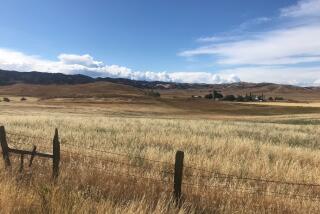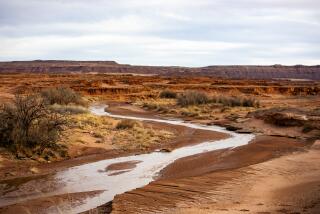Rains Revive San Juan Creek Dam Idea : Water: Runoff from Santa Ana Mountains could be stored for districts which now rely mainly on importation.
SAN JUAN CAPISTRANO — For some, the rare sight of water rushing beneath Camino Capistrano down San Juan Creek toward the Pacific Ocean is cause to rejoice. But for T.J. Meadows, it is downright painful.
Meadows, the general manager of the Capistrano Valley Water District for 37 years who now heads the San Juan Basin Authority, sees that surging water more as a dripping faucet and a lost opportunity.
“It’s sad, all that beautiful water going out to ocean,” Meadows said. “We’ve lost enough water already to supply us all year.”
The March rainfall that has South County rivers flowing again and the hillsides blossoming from brown to green has also added new luster to an idea that has been lingering in these parts for decades. Meadows and representatives of four South County water districts affiliated as the San Juan Basin Authority believe the time is right to move ahead with a dam about 12 miles up San Juan Creek from San Juan Capistrano.
One large dam, in the 50- to 100-foot range, and possibly one or two other smaller dams would allow the basin authority to store runoff rainwater as it flows down from the Santa Ana Mountains into San Juan Creek. As now proposed, the largest dam would be built in a wilderness area of Ronald W. Caspers Regional Park, at the mouth of San Juan Canyon just east of Ortega Highway.
According to a report from the U.S. Geological Survey, the amount of water that washed out to the ocean from San Juan Creek in a 24-hour period during a March 1 storm was equal to one-fifth of the entire 10,000-acre-foot annual demand of the city of San Juan Capistrano.
“That’s a huge flow of water, way too much to be wasted,” Meadows said.
It is particularly wasteful in the eyes of the water districts that make up the San Juan Basin Authority--Santa Margarita, Moulton Niguel, Trabuco Canyon and Capistrano Valley. The Santa Margarita and Moulton Niguel districts now rely 100% on imported water, while the other two get about 90% of their water from imported sources.
Those water sources, including the Colorado River and Northern California, are being tapped more and more heavily each day, the result being higher prices for the water districts and higher water bills for consumers.
A report released this week by the Los Angeles Department of Water and Power said water prices will skyrocket during the next decade and water users can expect rate increases in double digits in each of the next 10 years. In the next few months alone, the price of imported water is expected to jump from $230 an acre-foot to $252, said William Knitz, general manager of the Santa Margarita Water District and president of the board of directors of the San Juan Basin Authority. An acre-foot is equivalent to the amount of water that a family of five uses in 18 months.
That puts the onus on local water districts to strive for something they have not enjoyed since pioneering times: independence, said “Colonel” Jack Foley, general manager of the Moulton Niguel Water District and another basin authority board member.
“This dam would certainly not make us totally independent, but it will give us some relief,” Foley said. “What we would do, however, is capture the water and let it percolate down into the basin below on a controlled basis, much like it’s done now on the Santa Ana River. It would provide us some discipline in the management of that water, which is now just running into the ocean.”
Managers of the 113,000-acre San Juan Creek basin would also use a dam to regulate the water flow to the ocean and to hold it for treatment into a potable resource. At the same time, a dam could prevent any threat of flooding to the Capistrano Valley area while possibly providing a wetlands area or reservoir, they maintain.
Meadows believes the timing is right because of the renewed awareness of water management brought on by the five-year drought. And the basin authority now also claims to have the support of Rep. Ron Packard (R-Carlsbad), a ranking member of the water resources subcommittee of the House Public Works and Transportation Committee.
Packard, who recently viewed the proposed dam area from the air with Meadows and other South County water experts, admits to being “impressed with the proposal.”
“Naturally, I am sensitive to the need for protecting the environment in this area. However, I am also fully aware of the critical need to capture some of the water runoff that now travels out to sea,” Packard said last week.
The San Juan Basin Authority is hoping for help from Packard in obtaining the approximately $40 million needed for such a project. One such federal source is the U.S. Bureau of Reclamation, which provides subsidies for dam projects.
Packard said he would “ensure that the project receives fair and equitable treatment” at the federal level. While not a cure-all, the project “represents another key piece in the overall picture to help California resolve its water problems,” Packard said.
Even before securing funding, however, lies the problem of winning local support. San Juan Canyon is a heretofore untouched wilderness area of sagebrush, sycamore and oak trees just outside the border of Cleveland National Forest and now part of a 7,600-acre county park.
Tim Miller, county parks manager, said he was present at an informal presentation on the project but has yet to see a formal plan.
“The obvious concern that has to be addressed is the effect it would have on that environment, for the wildlife and plant life there,” Miller said. “One of our gravest concerns is a white alder forest in the area, one of the few natural strands of white alders in any park.”
Pete DeSimone, manager of the National Audubon Society’s Starr Ranch reserve, which shares a common border with Caspers Park, has also heard talk of dams in the area throughout the years.
“The idea has been kicked around for quite a while, although I thought it had been shelved,” DeSimone said. “It’s a sensitive issue in a biologically sensitive area. Hopefully, if they did it they would attempt to do it right. But that area is one of our last strongholds of wildlife habitat in this area.”
But the water basin managers have selected San Juan Canyon as “an ideal canyon.”
“It has the correct topography for a dam. The bedrock is very high, which is what is needed for stability of a dam. And it has the natural contours for making an ideal basin,” Foley said.
As for the environmental impacts, Meadows says the San Juan Basin Authority would attempt to mitigate any concerns.
“The last thing in the world we want to do is start a war with anybody over this thing,” Meadows said. “We obviously will have to cooperate with the county, the state Department of Fish and Game, and everyone out there. But we think we can proceed and protect, maybe even enhance that environment. We also think now is the time to do this.”
More to Read
Sign up for Essential California
The most important California stories and recommendations in your inbox every morning.
You may occasionally receive promotional content from the Los Angeles Times.










